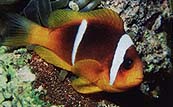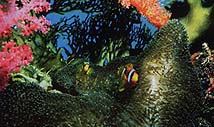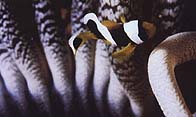SAFE HAVEN FOR A CLOWN
by "FishEye"
Pictures by Hans Sjoholm, Simon C. Hackett & Hagen Schmid
 Clownfish
are one of the favourite subjects for the underwater photographer. These
little fish are beautifully coloured, reliably found at the same place
every day, and are not shy. In fact they are quite brave and often swim
towards any intruder in the hope of chasing him or her away. For the photographer
this can be something of a problem for it is often impossible to focus
as close as the clownfish comes to the camera.
Clownfish
are one of the favourite subjects for the underwater photographer. These
little fish are beautifully coloured, reliably found at the same place
every day, and are not shy. In fact they are quite brave and often swim
towards any intruder in the hope of chasing him or her away. For the photographer
this can be something of a problem for it is often impossible to focus
as close as the clownfish comes to the camera.
Another name for these animals is anemone fish because they live in close association with sea anemones, themselves quite aggressive invertebrates that feed upon small fish, crabs and plankton. The food is caught by the anemone's tentacles which are themselves armed with powerful stinging cells called nematocysts, and coated by a sticky mucus. Biologists were at first confused about how the clownfish could swim unharmed among the stinging tentacles of the anemone.
 The
answer to this conundrum was solved a number of years ago when it was realised
that the clownfish have a clever means of immunising themselves against
the stinging anemones. Before adopting an anemone as a safe haven the clownfish
carefully rubs itself against the mucus clad tentacles, coating its own
body with the anemone's mucus. It seems that the anemones do not then recognise
the fish as either potential food or potential enemies and the clownfish
are then free to swim among the tentacles unharmed.
The
answer to this conundrum was solved a number of years ago when it was realised
that the clownfish have a clever means of immunising themselves against
the stinging anemones. Before adopting an anemone as a safe haven the clownfish
carefully rubs itself against the mucus clad tentacles, coating its own
body with the anemone's mucus. It seems that the anemones do not then recognise
the fish as either potential food or potential enemies and the clownfish
are then free to swim among the tentacles unharmed.

A problem arises however with the offspring of clownfish; how to protect
them from the potentially lethal adopted guardian? The parent fish deposit
their eggs on rock surfaces underneath the anemone and they regularly tend
to them by blowing water across them, ensuring a regular supply of oxygen-rich
water and preventing fungal growth. In order to protect the actual eggs
from the stinging anemone's tentacles the parent clownfish takes a mucus
coated tentacle in its own mouth and then rubs it gently over the developing
embryos within the attached egg masses prior to them emerging as vulnerable
fry. As soon as the baby fish do hatch they can avoid predators by hiding
among the protective tentacles of the anemone. There they can grow up in
safety until they move off to establish their own new home.
Contents
| News
| E-Mail
| Book
Reviews |
Home |
Back Issues
Web Links |
Forum |
Subjects |
Search |
Current Issue
| Subscribe
Arabian Wildlife. Volume 2, Number 1